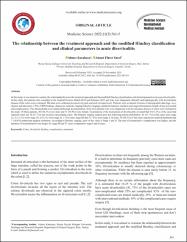| dc.contributor.author | Karakaya, Ahmet | |
| dc.contributor.author | Yücel, Ahmet Fikri | |
| dc.date.accessioned | 2023-02-28T08:29:14Z | |
| dc.date.available | 2023-02-28T08:29:14Z | |
| dc.date.issued | 2022 | en_US |
| dc.identifier.citation | Karakaya, A. & Yücel, A.F. (2022). The relationship between the treatment approach and the modified Hinchey classification and clinical parameters in acute diverticulitis. Medicine Science, 11(2), 561-565. http://doi.org/10.5455/medscience.2021.09.316 | en_US |
| dc.identifier.issn | 2147-0634 | |
| dc.identifier.uri | 10.5455/medscience.2021.09.316 | |
| dc.identifier.uri | https://hdl.handle.net/11436/7719 | |
| dc.description.abstract | In this study, it was aimed to examine the relationship between the treatment approach and the modified Hinchey classification and clinical parameters in acute diverticulitis.
In this study, the patients who consulted to the hospital between March 2010 and February 2015 and who were diagnosed clinically and radiologically with diverticulum
disease of the colon were evaluated. The data were collected prospectively and analysed retrospectively. Patients were evaluated in terms of demographic data (age, sex),
clinical and laboratory ( Wbc, CRP) findings, diagnostic methods, staging (Hinchey staging), applied treatments (medical and surgical treatment), length of stay in hospital
and complications. The obtained data were analysed through documentation. Sixty-five patients who were diagnosed with diverticulum disease of colon were included in
the study. Of these patients, 30 (46.2%) were male and 35 (53.8%) were female. Examination of the localization of diverticulitis revealed that 47(72.3%) of the cases had
sigmoid colon and 18 (27.7%) had localized descending colon. The Hinchey staging method gave the following patient distribution: 44 (67.7%) of the cases were stage
1a, 8 (12.3%) were stage 1b, 6 (9.2%) were stage II, 2 (3%) were stage III and 5 (7.8%) were stage 4. In total, 58 (89.2%) of the cases underwent medical treatment and
7 (10.8%) underwent surgical treatment. According to Hinchey staging, most of the cases is Stage I and II. The rate of postoperative complication was higher, and the
duration of hospitalization was longer for stage III and IV cases compared to stage I and II cases. | en_US |
| dc.language.iso | eng | en_US |
| dc.publisher | Effect Publishing Agency ( EPA ) | en_US |
| dc.rights | info:eu-repo/semantics/openAccess | en_US |
| dc.subject | Colon | en_US |
| dc.subject | Diverticul | en_US |
| dc.subject | Hinchey | en_US |
| dc.subject | Complication | en_US |
| dc.subject | Treatment | en_US |
| dc.title | The relationship between the treatment approach and the modified Hinchey classification and clinical parameters in acute diverticulitis | en_US |
| dc.type | article | en_US |
| dc.contributor.department | RTEÜ, Tıp Fakültesi, Cerrahi Tıp Bilimleri Bölümü | en_US |
| dc.contributor.institutionauthor | Karakaya, Ahmet | |
| dc.identifier.doi | 10.5455/medscience.2021.09.316 | en_US |
| dc.identifier.doi | 10.5455/medscience.2021.09.316 | en_US |
| dc.identifier.volume | 11 | en_US |
| dc.identifier.issue | 2 | en_US |
| dc.identifier.startpage | 561 | en_US |
| dc.identifier.endpage | 565 | en_US |
| dc.relation.journal | Medicine Science | en_US |
| dc.relation.publicationcategory | Makale - Uluslararası Hakemli Dergi - Kurum Öğretim Elemanı | en_US |


















